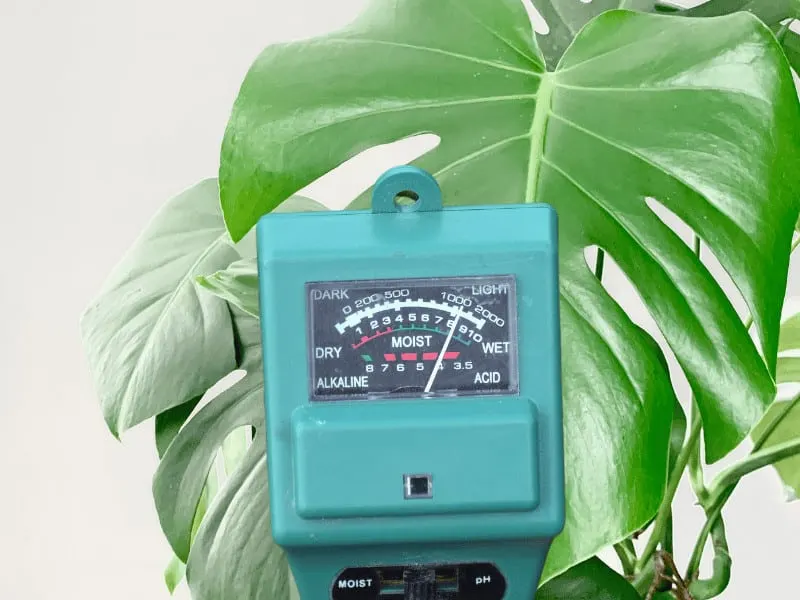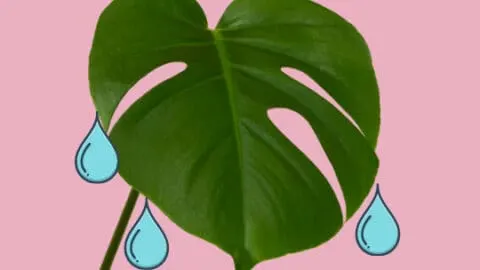A Monstera deliciosa weeps if it is overwatered. Monstera deliciosa, also popularly called the Swiss Cheese plant, is rooted in the Southern Mexico tropical forests. Its title of Swiss Cheese was given because its leaves develop holes or eyes similar to the holes in Swiss cheese.
It belongs to the Arum family Araceae with aerial roots and can grow up to 66 ft (20 m) high. A Monstera can become enormous in the wild, with leaves spreading two feet wide.
Typically, a Monstera Deliciosa grows well in a spacious environment, so it is always a good idea to put it in an open space instead of a tight corner.
In addition, Monstera deliciosa starts producing water droplets on the edges of its leaves when watered too much.
Table of Contents
Why Is My Monstera Deliciosa Weeping?
When a Monstera Deliciosa is watered, it sucks the water up but does not know when to stop. Therefore, when it takes in more water than required, the leaves expel it along with some minerals that no longer add to its growth. The process is collectively known as guttation, and what seems like water dropping from the leaves is xylem sap. The process is also commonly referred to as weeping, crying, or sweating, as droplets usually form on the tips of the leaves.

Is Guttation Bad?
Guttation is a natural process; however, it is crucial to understand the difference between guttation, sticky residue, and dew. Even if guttation is not harmful, it is a sign to look over your plant’s feeding and watering habits again.
Guttation, at times, could mean you are overwatering your plant. Since Monsteras are pretty resilient, they can absorb water to a great extent. However, that does not mean you should overwater them often.
Overfertilization
Guttation can also help you figure out if you are over-fertilizing your plant. If the guttation droplets appear white, like an ink blot, it may indicate overfertilization.
Overfertilizing your Monstera Deliciosa can result in leaf burn. However, white droplets do not always indicate over-fertilization, as the xylem sap is a mixture of water and minerals.
Difference Between Guttation and Dew
As described, guttation is when water and other waste are forced inside the Monstera Deliciosa. On the other hand, Dew is a result of moisture in the air.
When humidity combines with moisture during the day, it settles on the plant’s surface in drops.
Difference Between Guttation and Honey Dew
A sticky residue known as honeydew on your Monstera deliciosa could indicate pests. Pests can be harmful if they keep feeding on the plant and are not dealt with immediately.
Honeydew is a result of sugars mixed with other nutrients inside the plant. While honeydew is harmless, the pest that secretes it could slowly kill the plant. Therefore, if you notice honeydew on your Monstera stems or leaves, examine it thoroughly.
Use a Moisture Meter for a Monstera deliciosa
To ensure further accuracy, you can also purchase a moisture meter and use it once a week to monitor your Monstera Deliciosa. It will indicate if the soil humidity is low, medium, or high, indicated by dry, moist, and wet.
You want your moisture meter to indicate moist but not wet. Water once the moisture meter is almost displaying dry.

Caring for a Weeping Monstera Deliciosa
Adjust Water Schedule
Over-watering or under-watering your Monstera Deliciosa can cause moisture stress; therefore, it is important to find the balance. A Monstera Deliciosa’s water schedule depends on several factors, such as the climate, the material of the pot, and most importantly, the size of the plant.
For a young, medium-sized plant in a ceramic pot, the watering needs to be done once a week.
There is also another way to know when your Monstera Deliciosa is thirsty, and that is when it starts drooping. However, all young Monsteras are not the same. Some grow relatively faster and love being drenched after every few days.
You can also check the soil using your finger. Once you stick it into the dirt, go down by two inches. If it feels wet, the Monstera does not need to be watered and can wait a few days, but if it feels dry, you can water it right away.
Remove Pests
The two common types of pests are mealy bugs and spider mites. Mealybugs can cause discoloration as they consume the juice of leaves. You can rid your Monstera of these bugs by dabbing them with rubbing alcohol on a cotton swab.
Spider mites also consume the plant’s sap, causing discoloration. They often gather under the leaves and look like brown dots. They can be easily dislodged by using a kitchen syringe filled with water. Once these clusters are removed, you can shower the plant with warm water.
Frequently Asked Questions
What are some signs that my Monstera Deliciosa is over-watered?
There are plenty of signs to tell that your Monstera could be over-watered. Some are leaves turning yellow, stems getting mushy, mold on the soil surface, and dark brown colored spots on leaves.
What are the signs that my Monstera Deliciosa is under-watered?
Just like there are signs to indicate over-watering, there are also quite a few for under-watering. Some are crispy or wrinkled leaves, drooping leaves, dry brown spots, yellowing, and soil coming out from the pot edges.
What is the ideal temperature for Monstera Deliciosa to grow?
The ideal temperature should remain between 68 to 86 degrees Fahrenheit (20-30 degrees Celsius). However, if you reside in a dry area, occasionally misting your plant can help increase humidity around it. You can also purchase a humidifier to create an ideal environment.
Takeaways

Daniel has been a plant enthusiast for over 20 years. He owns hundreds of houseplants and prepares for the chili growing seasons yearly with great anticipation. His favorite plants are plant species in the Araceae family, such as Monstera, Philodendron, and Anthurium. He also loves gardening and is growing hot peppers, tomatoes, and many more vegetables.


